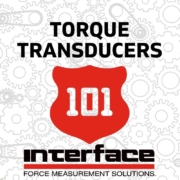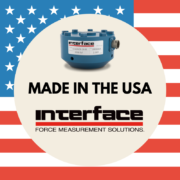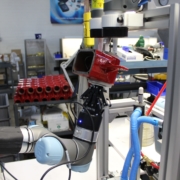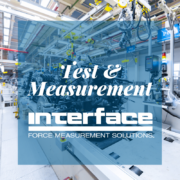Industry 5.0 and the Role of Force Measurement
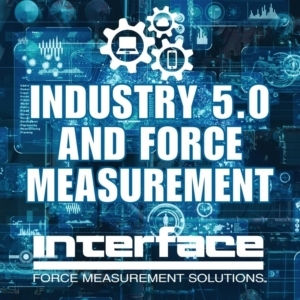
The next industrial revolution is coined Industry 5.0. The fifth wave of significant advancement comes on the heels of Industry 4.0, which focused on efficiency and productivity enhancements. The next revolution in our midst is heavily dependent on data, sensors, and enablement tools used for industrial automation. Of course, that means sensor solutions from Interface are perfectly aligned in facilitating the next advancements.
The use of artificial intelligence (AI), robotics, and other smart-enabled technologies are at the heart of Industry 5.0. To further automate and optimize production processes, there is a strong emphasis on human-centricity, sustainability, and resilience. Interface is working with industry leaders, integrators, and innovators to provide advanced sensor technologies that will support the adoption of Industry 5.0 products, with all the benefits of optimization and reliability.
One of the challenges in the design and implementation of Industry 5.0 solutions is interconnectivity. To maximize the connectivity between humans and machines, the equipment needs to be tested and monitored utilizing different sensors for adoption, efficiency and dependability. The use of robotics, AI, and other smart technologies are leading to sustainability in industrial and manufacturing facilities. This requires measurement data that is accurate and easily retained for continuous improvements. Learn more in our case study: Advancements in Robotics and Cobots Using Interface Sensors.
Wireless Enabled Force Measurement
The use of wireless and Bluetooth technologies is common for facilitating the connection between sensors and data analysis used in defining how these technologies are used in manufacturing and industrial environments. Using wireless load cells with wireless digital instrumentation, data is used for real-time adjustments and performance monitoring. This is particularly important in managing environmental worker safety working in collaboration with advanced machines and robots. Check out our WTS and BTS solutions for more options.
For robotics in particular, free range of motions is particularly important. This is standard in future use, especially as manufacturers grow in dependency in advanced robotics use cases across the manufacturing continuum. To test advanced robotics and accurate movement for different axes, multi-axis sensors are a smart choice due to their capabilities in simultaneously measuring 2, 3, and 6 axes at a time. These sensors are paired with data acquisition systems like our BX8 Data Acquisition System for Multi-Axis Sensors to fully utilize the depth of measurement data for better decisions.
We also help to enable automation across the production line. Our products test the quality, durability and accuracy in performance of machines and other equipment used for various functions across the line. This includes cases of using miniature load cells in equipment that rely on exact force to press a design on a fragile consumable, to verifying accuracy of intricately machined parts using multi-axis sensors for production lines. We have provided sensors for industrial automation solutions to thousands of customers using standard and custom application-specific sensors.
Industry 5.0 Applications Using Interface Solutions
Included below are a few Industry 5.0 applications in which Interface solutions have been used to test or monitor equipment.
Cobot Safety Programming
Collaborative robots, what are termed as cobots, are an Industry 5.0 advancement used in many manufacturing operations. With product testing and design enhancements based on sensor data, protective cages or fences are no longer needed for safety purposes. However, safety testing is required to ensure humans and robots can work alongside each other. For this application, Interface suggests using four 3A40 3-Axis Load Cells (creating one 6-Axis Force Plate) installed between two metal plates at the base of the cobot. In addition to installing the multi-axis force plate under the cobot, we also suggest using two ConvexBT Load Button Load Cells in the pinchers of the cobot. If a human were to knock into the cobot, or have a limb stuck in the pincher, the cobot would sense the amount of force measured from the load cells and be programmed to stop immediately. Our BX8-HD44 BlueDAQ Series Data Acquisition System for Multi-Axis Sensors with Lab Enclosure is used to gather measurements and report back in real-time for monitoring.
 6-Axis Force Plate Robotic Arm for Worker Safety
6-Axis Force Plate Robotic Arm for Worker Safety
A customer wanted to measure the reaction forces of their robotic arm for safety purposes. The reaction loads occurred at the robotic arm’s base; therefore, they needed a force measurement system at the base of the robotic arm. Interface suggested using their force plate option to install at the base of the robotic arm. Four 3-Axis Force Load Cells are installed between two force plates, then installed at the bottom of the arm. This creates one large 6-Axis Force Plate. The sensors force data is recorded and displayed through the two BX8 Multi-Channel Bridge Amplifier and Data Acquisition Systems onto the customer’s computer. Interface’s 6-Axis Force Plate was able to successfully measure the reaction forces of the customer’s robotic arm while in action next to collaborating workers.
 Commercial Food Processing for Efficiency
Commercial Food Processing for Efficiency
A food processing plant wanted accurate results of their in-motion check weigher when food is weighted and processed down the belt. They wanted to ensure production line efficiency and food quality. The customer also wanted real-time results of their food being weighed, and a load cell that could endure the food industry’s grubby environment. Multiple of Interface’s SPI High Capacity Platform Scale Load Cells were installed in the customer’s in-motion check weigher at the specific points where the food is weighed on the belt. The SPI High Capacity Platform Scale Load Cells delivered precise weighing results. When connected to the 920i Programmable Weight Indicator and Controller, it gave the customer real time results of the weight of the food being processed. Using this solution, the customer got precise weighing results in real-time of the food being processed on their in-motion check weigher. They were also able to view all the load cells in use simultaneously with Interface’s instrumentation.
Robotics_InfographicPosterThere are many projected benefits of the next industrial revolution, Industry 5.0. Staying at the forefront in providing useable and sustainable sensor solutions is a key focus of Interface. We look forward to supporting those that are driving the changes and adoptions for numerous benefits, primarily those targeting:
- Increased productivity by automating tasks and optimizing production processes.
- Improved quality of products by using advanced technologies to monitor and control production processes.
- New products and services by using advanced technologies to create more personalized and customized products that work in collaboration, like cobots.
- Utilizing collaborative machines and tools to reduce reliance of humans for repetitive and dangerous tasks.
Each of these benefits can be accelerated in design, testing, and implementation with the use of high-accuracy force measurement solutions. Industry 5.0 is upon us and Interface has the expertise and experience to help in adoption and utiliziation. To learn more about our work in automation, robotics and more, go to Industrial Automation
Advancement in Robotics and Cobots Using Interface Sensors Case Study

